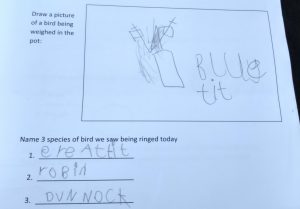Recent activities

RSPB WEX group ringing demo
The Rye Meads Ringing Group was approached by the RSPB at Rye Meads requesting a ringing demo…for 6—11 year old kids! Never a group to turn down a challenge, we jumped at the chance to inspire some of the youngsters.
We started with a very brief introduction in the classroom covering what bird ringing is, why we ring birds, what we’ve learnt, eg migration, how long they live, etc and the different rings and trackers used (as shown in a BTO ring display box). Posters were printed, some with maps on showing where some birds go in the winter; these were taken from the BTO website and quickly put together in Word! Being younger children we kept the introduction very brief (less than 5 minutes) and we soon went out to meet the rest of the ringers – who already had some birds!

We’d set three 60ft nets in a line along a track and had a 30ft net in the teaching area of the reserve; not our regular netting sites. This allowed the birds to be quickly transported to the RSPB visitor centre and awaiting kids and so kept handling time of the birds to a minimum. It also allowed a wander with the kids to the 30ft net, where they got to see a Great Tit being extracted and then, once empty of birds, to feel how soft the mesh is and see how it ‘works’ by gently throwing some small cuddly toy birds into the net pockets!
We managed to catch six species during the morning; Robin, Dunnock, Great Tit, Blackbird, Reed Warbler and Garden Warbler and the kids were identifying most things themselves. The only one to cause hesitation, but they got there on their own eventually, was the Garden Warbler, which for 6 to 11 year olds we thought was pretty good going. They were soon sexing the Great Tits too, something they’ll be able to do at home with they see Great Tits on the feeders. We’d also printed a world map so we could show just how far species like the Reed Warblers had flown to come here to breed, which the kids thought was pretty impressive.
We also created this ‘quiz sheet‘ for any of the kids who wanted one. It was in no way compulsory but the majority took a copy, clipboard and pencil – printed and prepared by the RSPB. This was not a school trip, it was a WEX group (Wildlife Explorers), so we wanted it to be both silly and educational. It went down very well and the kids were really laughing at some of the questions!




The questions were kept in mind and the ringers fitted the answers into their spiel along the way, prompting the kids to complete the quiz. We knew the drawings of the birds in the pots being weighed would be funny and they didn’t disappoint! (The birds were, of course, released before drawing commenced and did not have to stay as live models! Memory was used).
At the end of the day we finished with the grand finale; Kestrel pulli ringing and this went down very well!

It was informal and fun, while being calm and quiet when birds were in the hand. We would ring a few birds, go for a walk or have a chat, then ring a couple more. We didn’t want, nor did we get floods of birds to ring, which may have been too repetitive for them. It was great to see the enthusiasm from the kids, and the knowledge they already had! We hope to see some again when they are ready to start training to ring!!

Kestrel chicks (Brian Bishop)
We would recommend any ringing group thinking of doing a similar event to go for it – it was enjoyable for the kids, the ringers and the RSPB learning assistants (who obviously stayed, along with some of the parents and guardians, with the children at all times – so we didn’t have to worry about that side of things).
A massive thank you to Brian Bishop (RSPB, Learning Assistant) and Jan Swan (RMRG) for organising the two hour session and to everyone who helped on the day.
RMRG, June 2016.
